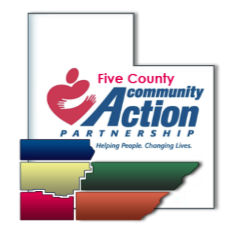Five County Association of Governments
A dedicated organization that works toward improving the lives of low-income households by helping them attain self-sufficiency. With the aid of the invaluable Community Service Block Grant (CSBG) funding, in addition to other funding sources, CAP has been able to establish strong partnerships with a wide range of organizations, enabling them to effectively address the pressing needs of the community. One of the key components of CAP’s strategy is their commitment to engaging community members through volunteerism, fostering a sense of collective responsibility and empowerment. Through these collaborative efforts, CAP has been able to make noteworthy strides in positively transforming the lives of those in need within the community.
Iron ♦ Washington ♦ Garfield ♦ Kane ♦ Beaver
Housing Assistance
The Five County Association of Governments offers assistance programs for homeless and at-risk households, including Rapid Re-Housing and prevention efforts. Our goal with these programs is to empower individuals and uplift the community.
Employment Support
Provides employment supports to help individuals thrive and succeed in their professional endeavors. We provide various services to help job seekers, like obtaining necessary documentation and transportation assistance, such as bus passes and gas voucher reimbursements.
Other Services
We offer free diapers to qualifying families, court ordered community service to those needing to fulfill that obligation, and access to other community resources and referrals as needed.
Housing Assistance Programs
Five County’s Community Action Partnership provides services to assist households with preventing and moving out of homelessness. These services are based on availability of funding and not guaranteed. The Community Action Partnership periodically has grants to assist with security or utility deposits, water and sewer payment assistance, rapid rehousing, and homeless prevention.
Employment Support
The CAP Department supports a flexible gas voucher program that is designed to provide essential transportation assistance to households that fall under 125% of the federal poverty line. This program specifically aims to assist individuals who are seeking to maintain employment but face financial challenges when it comes to transportation expenses. To ensure eligibility for gas reimbursements, clients must provide verification of their travel, meeting necessary conditions set forth by the program.
Court Ordered Community Service
The court-ordered Community Service program helps individuals avoid fines and incarceration by providing opportunities to give back and learn valuable skills. Participants serve their hours while contributing to society, promoting personal growth and helping to build a stronger community.
Free Diaper Program
The Free Diaper Program, initiated as a research pilot program, aims to monitor and assess the various advantages associated with providing free diapers to low-income families. By alleviating the financial burden of diaper expenses, this program seeks to enhance the overall well-being of families in need. Through data collection and analysis, we can determine the positive impact that this assistance initiative has on the lives of these families, enabling us to make informed decisions regarding future strategies to support them effectively.
Circles Program
Circles is a nationally-proven and innovative approach that focuses on connecting individuals from varying socioeconomic backgrounds, aiming to facilitate their transition out of poverty. It stands out from other programs by emphasizing the expansion of social networks for low-income individuals. By fostering a sense of community solidarity, Circles works to address the systemic barriers that perpetuate poverty, making a tangible impact on the lives of those it serves.
Make a contribution.
Would you like to make a meaningful impact and contribute to the inspiring work of the Community Action Partnership? Your generous donation, no matter the size, holds immeasurable significance to us. By joining our cause, you play a pivotal role in helping us extend a helping hand to even more individuals in need across our vibrant communities. Together, we can create a stronger and more resilient society, where every person has the opportunity to thrive.











